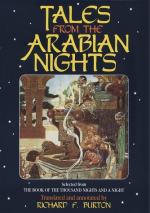It is perhaps hardly worth while to make a critical analysis of the tale of Aladdin, since with all its gross inconsistencies it has such a hold of the popular fancy that one would not wish it to be otherwise than it is. But it must have occurred to many readers that the author has blundered in representing the Magician as closing the Cave upon Aladdin because he refused to give up the Lamp before he had been helped out. As the lad was not aware of the properties of the Lamp, he could have had no object in retaining it for himself, while the Magician in any case was perfectly able to take it by force from him. And if he wished to do away with Aladdin, yet incur no “blood-guiltiness” (see ante, p. 52 and note), he might surely have contrived to send him down into the Cave again and then close it upon him. As to the Magician giving his ring to Aladdin, I can’t agree with Sir Richard in thinking (p. 48, note 1) that he had mistaken its powers; this seems to me quite impossible. The ring was evidently a charm against personal injury as well as a talisman to summon an all-powerful and obedient genie. It was only as a charm that the Magician placed it on Aladdin’s finger, and, as the Hindustani Version explains, he had in his rage and vexation forgot about the ring when he closed the entrance to the Cave. It appears to me also incongruous that the Lamp, which Aladdin found burning, should afterwards only require to be rubbed in order to cause the genie to appear. One should have supposed that the lighting of it would have been more natural or appropriate; and it is possible that such was in the original form of the Aladdin version before it was reduced to writing, since we find something of the kind in a Mecklenburg version given in Grimm under the title of “Des blaue Licht.” A soldier who had long served his King is at last discharged without any pay. In the course of his wanderings he comes to the hut




